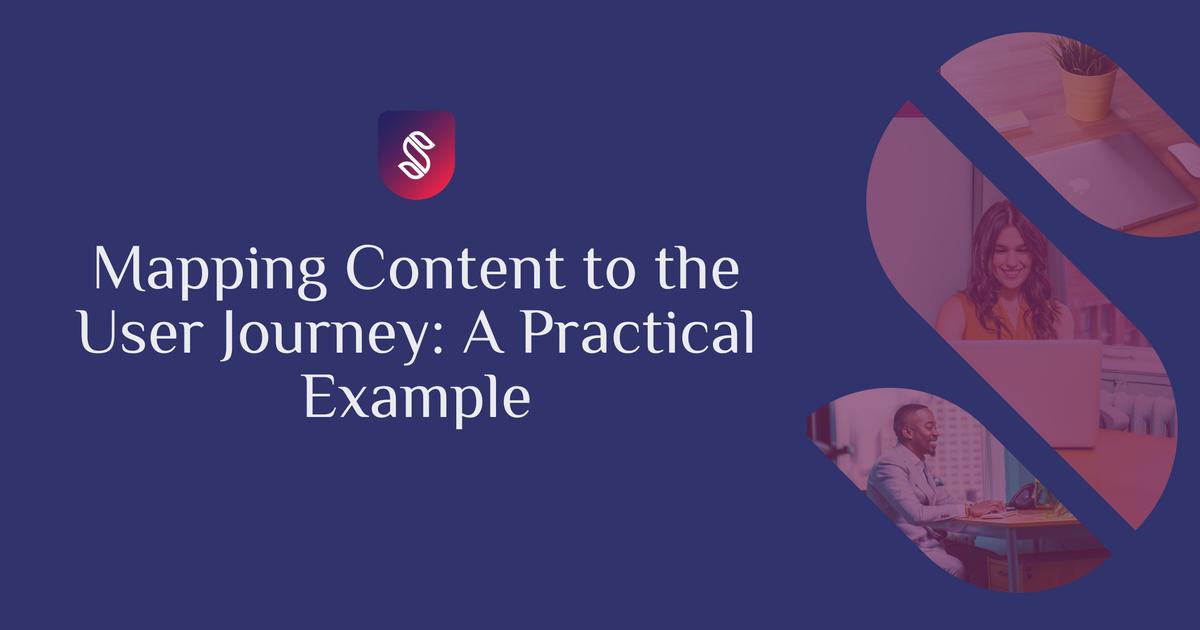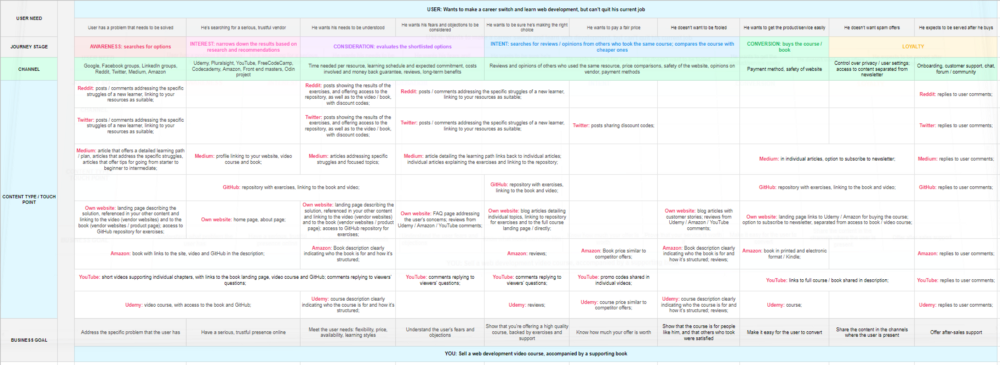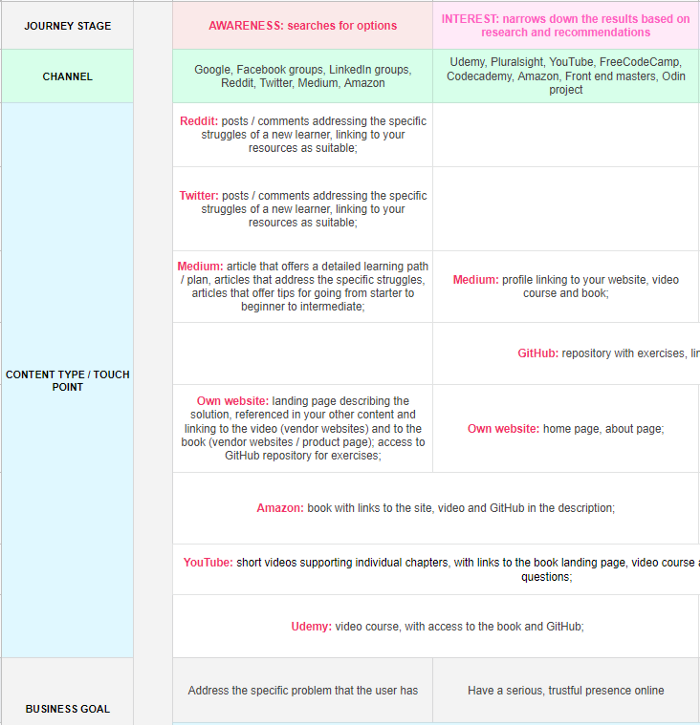Written on 24th May, 2021 | 5 min read
Mapping Content to the User Journey: A Practical Example
What content types to choose for each funnel stage & distribution channel
Andreea Macoveiciuc
Strategist @School of Content

One of the common mistakes beginner content writers and marketers make when planning their content topics is putting too much emphasis on keywords and neglecting the user journey.
Having a clear understanding of what the user wants from you and what you want from him should be the first step in any content marketing project.
By clarifying these two aspects — the user’s goal and your business goal, you can take a more strategic approach to the types of content you create and their mapping to the user journey.
In this article, we will look at the journey of a user who wants to make a career switch and to learn web development, but who can’t quit his current job.
Before exploring the scenario and mapping content types to the journey stages, I’ll explain the thinking behind this process, so that you can easily replicate this exercise and apply it to your niche.
The user journey is a two-way process
What we describe as “the user journey” is actually an exchange that takes place online. It’s a two-way process, so both parties — you and the potential customer — need to know and play by the rules.
The user won’t miraculously come to your website and buy whatever you’re selling unless you meet him halfway. What does it mean to meet the customer halfway through the journey? It means to:
have a serious and trustful online presence
know your customer’s needs
know your customer’s fears and objections
know what moves the needle
know how much a potential customer is willing to pay for your offer
AND
create content that reflects exactly these things
share the content in the channels where the user is present
be ready to offer after-sales support
This looks like a lot of work on your side, true? So how’s the user contributing to this process? How does the journey look for him?
For the potential customer, the online journey (regardless of the need) means that:
he has a problem that needs to be solved
so he wants to find a serious, trustful vendor
who understands his specific needs
and doesn’t downplay his fears and objections
who can convince him that he’s making the right choice
while asking for a fair amount of money
AND
who doesn’t try to fool him
who doesn’t bombard him with spam offers
and is available for questions after the deal is closed
If we describe the user journey like this, it becomes extremely clear what type of content we need to create for each step of this process. It also becomes clear what types of customers we want and what types we shouldn’t really bother with.
As counter-intuitive as it sounds, you don't want to run after all potential customers. If you own a restaurant, you don’t want to serve people who start complaining about the food and ask to be paid back.
In the same way, you don’t want customers who enter the restaurant and sit at a table for hours, without consuming anything. Surely, you will attract this type of user too, but I strongly believe you shouldn’t adjust your strategy based on their reactions.
Now let’s put the two sides of the journey on paper:

Image: mapping content user journey
Practical example: content types for promoting a video course/book
Let’s now explore the example: a user wants to make a career switch and learn web development.
His challenges:
can’t quit the current job;
he needs a flexible solution that allows him to study in his own time, from home;
limited budget; he can’t spend too much, his maximum budget is $100 per month;
loss of motivation; he gets bored quickly and loses motivation if he doesn’t see results soon;
no development background; he is afraid that he lacks the foundation;
slow learner; he needs to check multiple sources before understanding a concept, and often alternates between videos, articles, tutorials, and forums/communities where he asks specific questions;
His expectations:
find one complete, cohesive course that covers not only the basics but also the intermediate level of knowledge;
learn with real-life examples and practical exercises;
learn in his free time — after work, during weekends;
build a portfolio while learning that can help him get a job;
With this in mind, here are some potential channels and content types that you can create to cover the journey. Access the full example here.

Image: user journey content map
Content types mapped to the user journey
Let’s take a closer look at each stage. First, the Awareness phase.

Image: awareness
As you can see, there’s a lot of focus on Awareness, Consideration, and Interest phases. That’s where your competitors are, and that’s where the user will spend most of his time researching, comparing, evaluating options.
However, the content and presence in those channels should start only after the product (video course, book) is finalized.
NOTE: There are different approaches here, and some say it’s better to start promoting before you have a finished product. I strongly believe it’s good to be involved and to start being active in communities and groups before having the product ready, but I do not recommend promoting it yet.
Promoting something that’s not finalized will very likely lead to a rushed final offer. I’ve seen a lot of courses and books that start with in-depth information and really heavy content and end up with fluff.
And the Consideration stage:

Image: consideration
A common question is how many of these channels and content types to cover. Do you have to be present in all these channels and to create all this content?
No, just pick a few that match with your resources, preferences, and skills, and do your best to offer the best content and best support in those channels. If you’re not good at or don’t like creating videos, write the best book and supporting articles, and offer challenging exercises.
If you don’t like writing, create short, in-depth, and clear videos, and support them with a repository and / or exercise code snippets. Stick with what you’re good at, instead of offering thin content. Now, let’s see the Intent stage, with its mapped content.

Image: interest
Finally, here are the Conversion and Loyalty stages:

Image: conversion and loyalty
Of course, these channels can be replaced with the ones that are suitable for your niche and audience. The same goes for the content types: don’t create videos if your audience doesn’t consume them. At the same time, don’t create blog articles if your niche isn’t suitable for that.
If you own an e-commerce website selling kitchen products, for example, it may be wiser to show how the products are used than to write about them.
For a fitness brand selling home equipment, both videos and articles might be useful, while a company that does bathroom renovations should focus on photos and videos while having well-written service pages.
I hope this gives you a clear understanding of how to approach the mapping of content to the user journey.
If you need help developing your funnel or mapping content to each stage, get in touch with our team. We'll research your ideal customers and identify the content types most suitable for each step of the funnel, based on your goals.